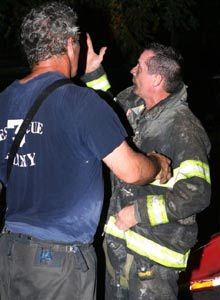 Photo Scott LaPrade/ Smokeshowingphotography.com |
The term communication means a lot of different things to a lot of different people. And in many organizations inside and outside the fire service it is often looked upon as a problem that needs to be addressed. The minute we are born we begin to participate in communication and, unfortunately, miscommunication. The first can bring about a great deal of satisfaction, the second a level of frustration that is hard for many to bear.
In the next several articles I plan on delving into the general issue of communication and how it plays out in the safety of both our members and the general public. Communications is clearly a big topic and just as we use grammar to establish rules of how we communicate (that’s why your 5th grade teacher kept harping on grammar), I need some framework within which to create these articles.
There are several models for outlining how we communicate. Most classes geared toward the NFPA 1021 Standard for Professional Fire Officer Qualifications utilize a standard communications model broken down into five distinct elements:
Sender: This is the beginning of the process; the person with the information that needs to be conveyed is the sender. As the sender you chose the “who, what, when, where, why, and how” of sending out this information. Who will it go to? What information will be delivered? When will it be delivered? Where will it be delivered? Why are you delivering it? And, of course, how will it be delivered? How you answer each of these questions has a dramatic impact on the message you send and therefore how it will be understood.
Message: Many of us have had a hard time at some point or another expressing an idea that seemed very clear in our head. The message, the actual “package” of information that you want to send out has a huge impact on how others will understand that information. Words (written and verbal) signs and numbers are all ways of creating a message to convey different information.
Medium: How we send out the message — e-mail, letter, phone call or face to face — can change how a message is received, what value it is given and ultimately how the information is treated. As our society changes so do our choices of medium — and each generation values and interprets them differently.
Receiver: Right now that’s you the reader. The person getting the message (or sometimes not) is of course the goal of communication. The receiver is the most important part. The first three line up to attempt to convey information to the receiver. There are many things that impact the receiver’s ability to receive and process information. In some ways I don’t like the term receiver as it sounds like that person has no active participation in the process. They just stand there and “receive” the information. In reality the receiver is incredibly important. The more active the role played by the receiver, the greater the ability for the information to be understood.
Feedback: This is how the sender knows (not assumes) that the information was received and more importantly was understood! A great number of senders forget to incorporate feedback into their communication. “I told them what to do, but they didn’t do it right, they just didn’t listen.” Throughout the upcoming series, you will discover that I strongly believe that the responsibility for communication begins and ends with the sender, not the receiver. If we send messages and don’t ensure feedback (don’t confuse feedback with opinions) occurs, we shouldn’t be surprised by an outcome that’s different to what we wanted.
We all communicate, even when we don’t mean to. Gaining greater control over your ability as a sender will allow you to be a great receiver as well. And ultimately a strong ability to communicate the message of safety will allow others to perform safely. I hope you will receive the upcoming articles well, and provide the feedback that the sender so desires. Until then, stay safe!












